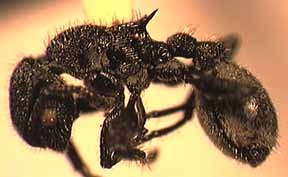

This manuscript name is a conditional proposal (sensu Article 15 of the 1985 ICZN), and thus not made available here. Its appearance here or in any duplication of this page does not constitute publication (sensu Article 8 of the 1985 ICZN).
Formicidae, Hymenoptera, Insecta, Arthropoda, Animalia
|
|
|
Image catalogue, worker (click here).
Ecuador.
Head subtriangular in outline, margin of vertex roughly straight. Frontal carina curves mesad at mid-torulus and joins adjacent longitudinal carina on clypeus. Frontal carina abruptly tapers as it curves mesad, becoming no more than a raised line appressed to dorsum of torulus and extending across to clypeal carina. Anterior half of torulus visible in face view. Torulus not recessed, juncture of anterior border of torulus and lateral clypeus subperpendicular, not forming a distinct trough in front of torulus. Clypeus not produced anteriorly in lateral view. Face with widely-spaced sharp rugae, forming a mesh of polygons posteriorly, more longitudinally oriented anteriorly. Intervals smooth and shining. Clypeus at level of antennal insertions abruptly bent ventrad. Clypeus with prominent median longitudinal carina, flanked with about 8 longitudinal carinae on each side. Anterior border of clypeus with median semicircular notch. Genae coarsely rugose foveate, rugae becoming more longitudinal across genal bridge. Mandible with coarse longitudinal striae. Eyes nearly symmetrically convex. Scape with flaring, asymmetrical flange over condyle and neck, narrowing above flange, broadening and flattening distally; surface of scape finely areolate, outer lateral margin with coarse rugae. Face and vertex meeting at an obtuse angle. Vertex margin weak, crenate, nearly obsolete medially. Vertex with parallel longitudinal striae; intervals smooth and shining.
Mesonotal lobes in the form of short, subtriangular tubercles. Propodeal suture strongly impressed laterally (dorsal view), faintly impressed dorsally, not breaking sculpture. Anterolateral propodeal lobes absent. Anterior border and sides of mesosomal dorsum approaching a foveate condition (similar to mesh of polygons on face, but with thicker, more confluent rugae). Foveate sculpture grading into longitudinal, subparallel striae on medial promesonotum and medial propodeal dorsum. Foveate sculpture of anterior border of pronotum extends onto flat lateral face of pronotum. Posterior half of lateral pronotal face longitudinally striate. Katepisternum and lateral face of propodeum with continuous longitudinal striae. Anepisternum and dorsolateral propodeum around spiracle with extension of lateral foveate sculpture on dorsum. Propodeal dorsum and declivous face meet at obtuse angle. Declivous face largely smooth and shining, with two curved, transverse striae between bases of propodeal spines. Posterior face of pro- and mesofemur longitudinally striate, intervals micropunctate. Posterior face of metafemur smooth, shining, microreticulate. Outer surface of protibia longitudinally rugulose. Outer surface of meso- and metatibia coarsely foveate rugose.
Dorsum of petiole with wavy rugae anteriorly, rugose foveate posteriorly. Dorsum of postpetiole with longitudinal, somewhat wavy rugae anteriorly, rugose foveate posteriorly.
AT4 with closely-spaced, subparallel, longitudinal rugulae near postpetiolar insertion, gradually breaking up and fading posteriorly; disc irregularly and faintly rugulose punctate, intervals shiny; rugulae strengthening somewhat, becoming more longitudinal at posterior border. AT5-7 transversely rugulose. AS4 with 6-7 longitudinal rugulae on each side, from postpetiole to about midlength; rest shining with sparse but distinct puncta.
More than 100 short stiff setae distributed uniformly on disc of face. Abundant stiff setae on mesosomal dorsum (more than 100 on promesonotum), longer than those on face. Setae on petiole and postpetiole abundant, longer than those on mesosomal dorsum. AT4 with moderately abundant suberect setae, about as long as those on face. AT4 setae underlain with a dense, yellowish, decumbent pubescence, which gives a distinctive wooly appearance to gaster.
Largely black, distally grading to dark red brown on appendages.
Measurements of holotype worker: HW 1.36, HL 1.43, SL 1.08, EL 0.41, MeL 1.99, MeW 1.04, PrL 0.52, PrS 0.33, PrT 0.85, MTL 1.27, MFL 1.33, MFW 0.39, PtL 0.52, PtW 0.49, PpW 0.66, PtH 0.40, AL 1.69, AW 1.52.
This species is known from two specimens from a montaine site, and nothing is known of its biology. Its morphological similarity to P. mayri and P. batesi predict similar habits.
Provisional holotype worker: Ecuador, Pastaza Prov., Shell Mera, 1064m, 9 Feb 1955 (E. I. Schlinger & E. S. Ross), LACM ENT 140115 [LACM ]. Paratype worker: Ecuador, Pastaza Prov., 6-8mi. W. Mera, 1500m, 10 Feb 1955 (E. I. Schlinger & E. S. Ross), LACM ENT 140116 [MCZC].
Page author:
John T. Longino, The Evergreen State College, Olympia WA 98505 USA. longinoj@evergreen.edu
Date of this version: 2 September 1998.